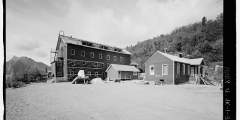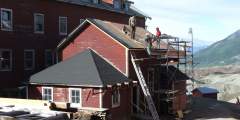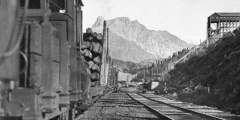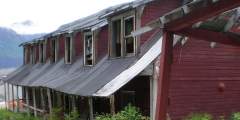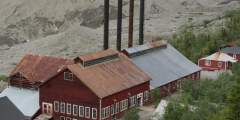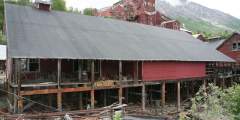This abandoned copper mining camp is a National Historic Landmark District. Established in 1903, Kennecott Mining Corporation operated 5 mines in the area. Kennecott became a bustling mining camp filled with miners and their families. In 1925, a geologist predicted that the area would soon be mined out. By 1938, Kennecott was a ghost town.
Today, Kennecott is a popular tourist attraction and the National Park Service is currently stabilizing and rehabilitating many of the mill and town buildings.
The iconic view in Kennicott is the giant red mill building from the old Kennecott Copper Company, which stands 14 stories above the Kennicott glacier (the different spellings are due to clerical mistakes on official paperwork a century ago).
How to See It
Without a Guide: You can explore the area on your own following a map from the National Park Service.
With a Guide: Take a guided tour with St. Elias Alpine Guides, a local company that has been granted special permission to take travelers not only around the town, but also inside the buildings.
Historic Details: The Discovery of Copper
Copper became an extremely valuable mineral at the turn of the century due to the inventions of electricity, automobiles, and telephones. In the summer of 1900, prospectors Clarence Warren and Jack Smith were exploring Kennecott Glacier and came across the richest concentration of copper ore ever discovered. The samples they collected from Bonanza Peak’s magnificent green cliffs of exposed copper revealed up to 70% of pure chalcocite.
The Development of the Mines
J.P. Morgan and several other wealthy families collaborated to form the Alaska Syndicate and capitalize on this rich mineral source. They hired Michael J. Heney, who had previously built the White Pass & Yukon Railroad. It took Heney and his crews 4 years of tireless labor in temperatures as low as 40 degrees below zero to build the rail bed and bridges through the regions rough terrain. Steven Birch, a mining engineer, was hired to develop the Kennecott mining claims. He used dog sleds to haul entire steamships, piece by piece, from Valdez. He reassembled them on the Copper River, and used them, as well as horses and dog sleds, to bring in equipment and begin mining before the railroad was even finished. The railroad was completed in 1911 and the Kennecott Mines quickly established itself as a model of state-of-the-art technology and progressive management.
The Active Kennecott Mines
The Kennecott Copper Corporation lured workers to this isolated Alaskan mining camp with higher salaries than any mine in the lower 48 offered. Mill workers and miners lived in bunkhouses, worked 7 days a week and sent money home to their families. Between their hard work and the ingenuity of the founders, Kennecott Copper Corporation produced at least $200 million worth of ore, making it one of the world’s largest mineral companies. Profits were used to expand the corporation by investing in mines in Chile and the lower-48.
From the Close of the Mines to Today
Despite all the initial success, the low price of copper during the Great Depression took it’s toll on the Kennecott Mines. By 1938, all known ore deposits had been depleted. The mines closed their doors, the railroad shut down, and Kennecott became a ghost town with only a handful of residents remaining. In the 1960’s the Kennecott Copper Corporation sold its land, structures, and surface mining rights to Consolidated Wrangell Mining Co. The Great Kennecott Land Company was formed in 1976 and the town and surrounding land was subdivided and put up for sale to private owners. A group of doctors and lawyers from Anchorage purchased the property (including Jim Harrower, an Anchorage dentist who ran a wilderness lodge deep in the Alaska Range on the Stony River--where Alaska.org founder Bob Kaufman spent his first winter in Alaska in 1988).
Brad Meiklejohn of the Conservation Fund helped the Park Service acquire the property in June, 1998. Today, this old mill town is a National Historic Landmark, and has become one of Alaska’s most popular destinations.



